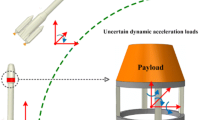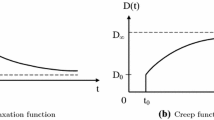Abstract
The paper concerns worst-case compliance optimization by finding the structural topology with minimum compliance for the loading due to the worst possible acceleration of the structure and attached non-structural masses. A main novelty of the paper is that it is shown how this min-max problem can be formulated as a non-linear semi-definite programming (SDP) problem involving a small-size constraint matrix and how this problem is solved numerically. Our SDP formulation is an extension of an eigenvalue problem seen previously in the literature; however, multiple eigenvalues naturally arise which makes the eigenvalue problem non-smooth, whereas the SDP problem presented in this paper provides a computationally tractable problem. Optimized designs, where the uncertain loading is due to acceleration of applied masses and the weight of the structure itself, are shown in two and three dimensions and we show that these designs satisfy optimality conditions that are also presented.








Similar content being viewed by others
Notes
Note that the eigenvalues are not calculated explicitly in our formulation, it is done here as an additional step in order to create the plot.
Here we use \(\inf _{x} \big [\inf _{u} f(x,u)\big ] = \inf _{u} \big [\inf _{x} f(x,u)\big ]\) and \(\sup _{x} f(x) = -\inf _{x}\; [-f(x)]\), for x and u varying over arbitrary sets.
References
Achtziger W, Kocvara M (2007) Structural topology optimization with eigenvalues. SIAM J Optim 18(4):1129–1164
Altair Engineering Inc. (2014) HyperMesh 13.0, users manual
Aroztegui M, Herskovits J, Roche JR, Bazn E (2014) A feasible direction interior point algorithm for nonlinear semidefinite programming. Struct Multidiscip Optim:1–17. doi:10.1007/s00158-014-1090-2. ISSN 1615-147X
Ben-Tal A, El Ghaoui L, Nemirovski A (2009) Robust Optimization. Princeton Series in Applied Mathematics. Princeton University Press
Ben-Tal A, Nemirovski A (1997) Robust truss topology design via semidefinite programming. SIAM J Optim 7(4):991–1016
Bendsøe MP (1989) Optimal shape design as a material distribution problem. Struct Optim 1(4):193–202
Benson HY, Vanderbei RJ (2003) Solving problems with semidefinite and related constraints using interior-point methods for nonlinear programming. Math Program 2:279–302
Bogani C, Kocvara M, Stingl M (2009) A new approach to the solution of the VTS problem with vibration and buckling constraints. In: 8th World Congress on Structural and Multidisciplinary Optimization
Bonnans JF, Shapiro A (2000) Perturbation analysis of optimization problems. Springer
Boyd S, Vandenberghe L (2004) Convex optimization, Cambridge University Press
Brittain K, Silva M, Tortorelli DA (2012) Minmax topology optimization. Struct Multidiscip Optim 45 (5):657–668
Bruns TE, Tortorelli DA (2001) Topology optimization of non-linear elastic structures and compliant mechanisms. Comput Methods Appl Mech Eng 190(26-27):3443–3459
Bruyneel M, Duysinx P (2005) Note on topology optimization of continuum structures including self-weight. Struct Multidiscip Optim 29:245–256
Burer S, Monteiro RDC, Zhang Y (2002) Solving a class of semidefinite programs via nonlinear programming. Math Program 93:9702123
Cherkaev E, Cherkaev A (2008) Minimax optimization problem of structural design. Comput Struct 86(13):1426–1435
Christiansen S, Patriksson M, Wynter L (2001) Stochastic bilevel programming in structural optimization. Struct Multidiscip Optim 21(5):361–371
Dunning PD, Kim HA (2013) Robust topology optimization: minimization of expected and variance of compliance. AIAA J 51(11):2656–2664
Ertel S, Schittkowski K, Zillober C (2008) Sequential convex programming for free material optimization with displacement and stress constraints. Technical report, Department of Computer Science. University of Bayreuth
Fletcher R (1985) Semi-definite matrix constraints in optimization. SIAM J Control Optim 23:493–513
de Gournay F, Allaire G, Jouve F (2008) Shape and topology optimization of the robust compliance via the level set method. ESAIM Control Optim Calc Var 14(01):43–70
Guest JK, Prévost JH, Belytschko T (2004) Achieving minimum length scale in topology optimization using nodal design variables and projection functions. Int J Numer Methods Eng 61(2):238–254
Hestnes M (1975) Optimization theory. John Wiley & Sons
Hiriart-Urruty JB, Lemarchal C (1993) Convex analysis and minimization algorithms I. Springer
Horn RA, Johnson CR (1985) Matrix analysis. Cambridge University Press
IPOPT (2014) A tutorial for downloading, installing, and using IPOPT. http://www.coin-or.org/Ipopt/documentation/
Kanno Y (2011) An implicit formulation of mathematical program with complementarity constraints for application to robust structural optimization. J Oper Res Soc Jpn-Keiei Kagaku 54(2):65
Kharmanda G, Olhoff N, Mohamed A, Lemaire M (2004) Reliability-based topology optimization. Struct Multidiscip Optim 26(5):295–307
Klarbring A (2015) Design optimization based on state problem functionals. Struct Multidiscip Optim. doi:10.1007/s00158-015-1240-1
Kočvara M, Stingl M (2003) PENNON - A code for convex nonlinear and semidefinite programming. Optim Methods Softw 18:317–333
Lee E, James KA, Martins JRRA (2012) Stress-constrained topology optimization with design-dependent loading. Struct Multidiscip Optim 46(5):647–661
Ohsaki M, Fujisawa K, Katoh N, Kanno Y (1999) Semi-definite programming for topology optimization of trusses under multiple eigenvalue constraints. Comput Methods Appl Mech Eng 180(1):203–217
Overton ML (1992) Large-scale optimization of eigenvalues. SIAM J Optim 2(1):88–120
Pataki G (1998) On the rank of extreme matrices in semidefinite programs and the multiplicity of optimal eigenvalues. Math Oper Res 23(2):339–358
Pedersen NL, Nielsen AK (2003) Optimization of practical trusses with constraints on eigenfrequencies, displacements, stresses, and buckling. Struct Multidiscip Optim 25(5):436–445
Rockafeller RT (1972) Convex analysis. Princeton
Seyranian AP, Lund E, Olhoff N (1994) Multiple eigenvalues in structural optimization problems. Struct Multidiscip Optim 8(4):207–227
Sigmund O (2007) Morphology-based black and white filters for topology optimization. Struct Multidiscip Optim 33(4):401–424
Sigmund O, Petersson J (1998) Numerical instabilities in topology optimization: a survey on procedures dealing with checkerboards, mesh-dependencies and local minima. Struct Multidiscip Optim 16(1):68–75
Stingl M, Kocvara M, Leugering G (2009) Free material optimization with fundamental eigenfrequency constraints. SIAM J Optim 20(1):524–547
Svanberg K (1987) The method of moving asymptotes - a new method for structural optimization. Int J Numer Methods Eng 24(2):359–373
Takezawa A, Nii S, Kitamura M, Kogiso N (2011) Topology optimization for worst load conditions based on the eigenvalue analysis of an aggregated linear system. Comput Methods Appl Mech Eng 200(25):2268–2281
Thore C-J (2013) Fminsdp – a code for solving optimization problems with matrix inequality constraints. http://www.mathworks.com/matlabcentral/fileexchange/43643-fminsdp
Thore C-J, Holmberg E, Klarbring A (2015) Large-scale robust topology optimization under load-uncertainty. In: Proceedings, 11th World Congress on Structural and Multidisciplinary Optimization
Vanderbei RJ, Benson HY (2000) On formulating semidefinite programming problems as smooth convex nonlinear optimization problems. Technical report. Center for Discrete Mathematics & Theoretical Computer Science
Wächter A, Biegler LT (2006) On the implementation of an interior-point filter line-search algorithm for large-scale nonlinear programming. Math Program 106(1):25–57
Acknowledgments
This research was supported in part by NFFP Grant No. 2013-01221, which is funded by the Swedish Armed Forces, the Swedish Defence Materiel Administration and the Swedish Governmental Agency for Innovation Systems, and in part by the Swedish Foundation for Strategic Research, Grant No. AM13-0029.
Author information
Authors and Affiliations
Corresponding author
Appendices
Appendix A: Equivalence between bounded eigenvalue and SDP
Proposition 1
Let \(\boldsymbol {H}\in \mathbb {S}^{s}\) and \(\lambda _{1}(\boldsymbol {H}) = \max \limits _{i=1,\ldots ,s} \lambda _{i}(\boldsymbol {H})\) . Then
Proof
“\(\boldsymbol {H} - z\boldsymbol {I} \preceq \boldsymbol {0}\)” means that
where the equality to the left in the last line follows from the Rayleigh-Ritz theorem (Horn and Johnson 1985, Theorem 4.2.2). □
Appendix B: Worst-case compliance and optimization problem for a singular stiffness matrix
For a singular stiffness matrix \(\boldsymbol {K}\left (\boldsymbol {x}\right )\) the compliance is still a well-defined function and can be expressed as
where
is the total potential energy for a general nodal displacement v. (See Klarbring (2015) for a recent general discussion of compliance minimization.)
The worst-case compliance is defined as
By straightforward manipulations we getFootnote 2
The inner maximization problem is solved by noting that
using the Cauchy-Schwarz inequality and the fact that ||r||≤1 for r∈T. Equality holds for \(\boldsymbol {r}=\boldsymbol {B}\left (\boldsymbol {x}\right )\boldsymbol {v}/||\boldsymbol {B} \left (\boldsymbol {x}\right )\boldsymbol {v}||\), so we have
where the first equality follows from Rockafeller (1972, Corollary 32.3.1). Substitution in (19) yields
We are now interested in essentially the equivalent problem to (9), i.e.,
but now without requiring a non-singular stiffness matrix. As for (9) we rephrase it into a bound formulation, which, using (21), leads to the following optimization problem:
This is a semi-infinite problem since it has a finite number of variables, but an infinite number of constraints. However, it can be shown by the following theorem that this problem is equivalent to a semi-definite program.
Theorem
Proof
The proof resembles that of Lemma 2.2 in Ben-Tal and Nemirovski (1997).
Since the matrix is positive semi-definite,
Now let u=λ y and τ=λ κ. Then the last inequality is equivalent to
The latter holds in particular for \(\boldsymbol {\kappa } = {\arg \max }_{||\boldsymbol {\kappa }|| = 1} \boldsymbol {y}^{\textsf {T}}\boldsymbol {B}^{\textsf {T}}\boldsymbol {\kappa }\), for which y T B T κ=||B y||, see (20). The last inequality is thus equivalent to
□
Using this theorem, the semi-infinite optimization problem (22) can be formulated as the semi-definite program
This problem is convex if B and K are linear in x and does not require K to be non-singular. Unfortunately, currently available solvers for semi-definite programs are not suitable for matrix inequalities with large matrices (see however Bogani et al. (2009) and Stingl et al. (2009)).
For the special case of a non-singular stiffness matrix, we note two interesting results obtained from (23):
-
1.
We may use the Schur-complement theorem (Boyd and Vandenberghe (2004, p. 560-561), Horn and Johnson (1985, Theorem 7.7.6)) and (6) to rewrite (23) into (10) derived in Section 2.4.
-
2.
We may also obtain the generalized eigenvalue formulation proposed by Brittain et al. (2012). To start with, it is straightforward to show that
$$\left( \begin{array}{cc} z\boldsymbol{I} & \boldsymbol{B}\\ \boldsymbol{B}^{\textsf{T}} & \boldsymbol{K} \end{array} \right) \succeq \boldsymbol{0} \; \Leftrightarrow \; \left( \begin{array}{cc} \boldsymbol{K} & \boldsymbol{B}^{\textsf{T}} \\ \boldsymbol{B} & z\boldsymbol{I} \end{array} \right) \succeq \boldsymbol{0}. $$Then assuming z>0 and applying the Schur-complement theorem to the right side of the equivalence one finds that this inequality is equivalent, in turn, to
$$\begin{array}{@{}rcl@{}} \boldsymbol{K} - z^{-1}\boldsymbol{B}^{\textsf{T}}\boldsymbol{B} \succeq \boldsymbol{0} && \qquad\qquad\qquad\qquad \Leftrightarrow \\ \boldsymbol{x}^{\textsf{T}}\left( \boldsymbol{K} - z^{-1}\boldsymbol{B}^{\textsf{T}}\boldsymbol{B}\right)\boldsymbol{x} \geq 0 && \forall \boldsymbol{x} \in \mathbb{R}^{n}\qquad\qquad \Leftrightarrow \\ z \geq \frac{\boldsymbol{x}^{\textsf{T}}\boldsymbol{B}^{\textsf{T}}\boldsymbol{B}\boldsymbol{x}}{\boldsymbol{x}^{\textsf{T}}\boldsymbol{K}\boldsymbol{x}} && \forall \boldsymbol{x} \in \mathbb{R}^{n}\qquad\qquad \Leftrightarrow \\ z =\max_{||\boldsymbol{x}||=1} \frac{\boldsymbol{x}^{\textsf{T}}\boldsymbol{B}^{\textsf{T}}\boldsymbol{B}\boldsymbol{x}}{\boldsymbol{x}^{\textsf{T}}\boldsymbol{K}\boldsymbol{x}} & =& \mu_{1}(\boldsymbol{K},\boldsymbol{B}^{\textsf{T}}\boldsymbol{B}), \end{array} $$where μ 1(⋅,⋅) is the largest generalized eigenvalue of a given matrix pencil. The last step in the above chain of equivalences follows from Theorem 2.4 in Hestnes(1975, Chapter 2). Problem (23) can now be replaced by
$$\min_{\boldsymbol{x}\in\mathcal{H}} \mu_{1}(\boldsymbol{K}(\boldsymbol{x}),\boldsymbol{B}(\boldsymbol{x})^{\textsf{T}}\boldsymbol{B}(\boldsymbol{x})), $$which is similar to the generalized eigenvalue formulation found in Brittain et al. (2012).
Rights and permissions
About this article
Cite this article
Holmberg, E., Thore, CJ. & Klarbring, A. Worst-case topology optimization of self-weight loaded structures using semi-definite programming. Struct Multidisc Optim 52, 915–928 (2015). https://doi.org/10.1007/s00158-015-1285-1
Received:
Revised:
Accepted:
Published:
Issue Date:
DOI: https://doi.org/10.1007/s00158-015-1285-1




